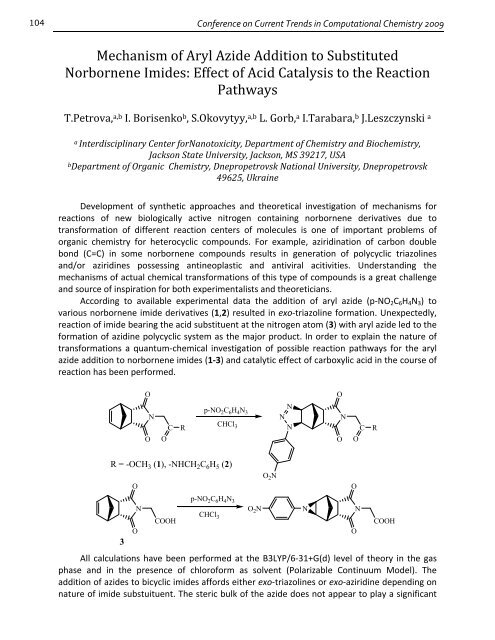Proceedings - Interdisciplinary Center for Nanotoxicity
Proceedings - Interdisciplinary Center for Nanotoxicity
Proceedings - Interdisciplinary Center for Nanotoxicity
You also want an ePaper? Increase the reach of your titles
YUMPU automatically turns print PDFs into web optimized ePapers that Google loves.
104<br />
Conference on Current Trends in Computational Chemistry 2009<br />
Mechanism of Aryl Azide Addition to Substituted<br />
Norbornene Imides: Effect of Acid Catalysis to the Reaction<br />
Pathways<br />
T.Petrova, a,b I. Borisenko b, S.Okovytyy, a,b L. Gorb, a I.Tarabara, b J.Leszczynski a<br />
a <strong>Interdisciplinary</strong> <strong>Center</strong> <strong>for</strong><strong>Nanotoxicity</strong>, Department of Chemistry and Biochemistry,<br />
Jackson State University, Jackson, MS 39217, USA<br />
b Department of Organic Chemistry, Dnepropetrovsk National University, Dnepropetrovsk<br />
49625, Ukraine<br />
Development of synthetic approaches and theoretical investigation of mechanisms <strong>for</strong><br />
reactions of new biologically active nitrogen containing norbornene derivatives due to<br />
trans<strong>for</strong>mation of different reaction centers of molecules is one of important problems of<br />
organic chemistry <strong>for</strong> heterocyclic compounds. For example, aziridination of carbon double<br />
bond (C=C) in some norbornene compounds results in generation of polycyclic triazolines<br />
and/or aziridines possessing antineoplastic and antiviral acitivities. Understanding the<br />
mechanisms of actual chemical trans<strong>for</strong>mations of this type of compounds is a great challenge<br />
and source of inspiration <strong>for</strong> both experimentalists and theoreticians.<br />
According to available experimental data the addition of aryl azide (p‐NO2C6H4N3) to<br />
various norbornene imide derivatives (1,2) resulted in exo‐triazoline <strong>for</strong>mation. Unexpectedly,<br />
reaction of imide bearing the acid substituent at the nitrogen atom (3) with aryl azide led to the<br />
<strong>for</strong>mation of azidine polycyclic system as the major product. In order to explain the nature of<br />
trans<strong>for</strong>mations a quantum‐chemical investigation of possible reaction pathways <strong>for</strong> the aryl<br />
azide addition to norbornene imides (1‐3) and catalytic effect of carboxylic acid in the course of<br />
reaction has been per<strong>for</strong>med.<br />
O<br />
O<br />
N<br />
C<br />
O<br />
R<br />
p-NO 2C 6H 4N 3<br />
CHCl 3<br />
R = -OCH 3 (1), -NHCH 2C 6H 5 (2)<br />
3<br />
O<br />
O<br />
N<br />
COOH<br />
p-NO 2C 6H 4N 3<br />
CHCl 3<br />
O 2N<br />
O 2N<br />
N<br />
N<br />
N<br />
N<br />
O<br />
O<br />
N<br />
C<br />
O<br />
O<br />
O<br />
N<br />
R<br />
COOH<br />
All calculations have been per<strong>for</strong>med at the B3LYP/6‐31+G(d) level of theory in the gas<br />
phase and in the presence of chloro<strong>for</strong>m as solvent (Polarizable Continuum Model). The<br />
addition of azides to bicyclic imides af<strong>for</strong>ds either exo‐triazolines or exo‐aziridine depending on<br />
nature of imide substuituent. The steric bulk of the azide does not appear to play a significant



